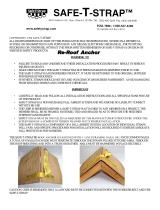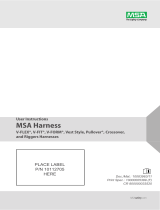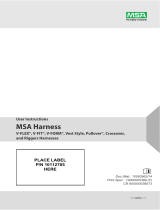
Pull each thigh strap (5) through the crotch
and fasten the parachute buckles by passing
the male buckle through the female. For
tongue buckle insert the grommeted strap
through the buckle. Fasten by inserting the
tongue through the grommet. For quick-
connect, insert male end into female end and
apply pressure until the locking tabs snap into
place. Ensure closure by checking tab positions
in buckle window. Be careful not to cross or
twist the straps.
5)
Adjust the tension of the thigh straps (5) by
pulling or releasing the slack end of the strap.
Move the plastic keeper away from the buckle
edge to ease adjustment. For tongue buckles
select desired grommet and secure excess
webbing under plastic keeper. Proper tension
is a 2-fi nger space between strap and leg.
6)
Attach the chest strap (2) parachute buckle
and adjust the length so that the shoulder
straps (1) are centered on each shoulder.
7) Position the plastic strap keepers so that
one is next to the parachute buckle and
the other is at the far end of the excess
strap. Be certain that the torso straps are
adjusted so that the dorsal D-ring is in
the center of the wearer’s back.
APPLICATIONS
PROTECTA Full Body Harnesses are designed
to provide the wearer with maximum comfort
while maintaining the highest degree of
protection from falls. In order for the harness
to be fully effective, it must be adjusted
properly to fi t the wearer, and attached to an
appropriate Personal Fall Arrest
System.
LIMITATIONS
Full body harnesses are designed to act in
concert with other elements of a Personal Fall
Arrest System and arrest a fall from height
while minimizing impact load on the wearer.
Users should not combine components or
subsystems of the PFAS from manufacturers
other than Capital Safety unless it is
determined by a qualifi ed person that they
are compatible with one another. Incompatible
components may interfere with the safe
operation or function of the equipment.
Unless otherwise noted, max. allowable free fall
shall not exceed 6’ (1.8 m).
Maximum User Weight not to exceed:
ANSI Z359.1 310 lbs (141 kg)
CSA Z259.10-06 352 lbs (160 kg)
OSHA 420 lbs (191 kg)
Environmental Hazards: Use of this equipment
with environmental hazards may require
additional precautions to prevent injury to the
user or damage to the equipment. Hazards
may include, but are not limited to: heat,
chemicals, corrosive environments, high voltage
power lines, gases, moving machinery, moving
vehicles and sharp edges. Contact Protecta if
you have questions about using this equipment
where environmental hazards may exist.
Training: This equipment is intended to be used
by persons trained in its correct application and
use.
INSTALLATION & OPERATION
The Personal Fall Arrest System (PFAS) attached to
the Full Body Harness may ONLY be attached to the
dorsal D-ring. Dorsal D-ring is for fall arrest ONLY.
Side-hip D-rings (if harness is so equipped) are
for positioning work. Chest loops, chest D-rings, or
shoulder D-rings are for attachment of guided type fall
arrest systems or for retrieval.
Before using this harness, check to ensure that all
components of the Personal Fall Arrest System are
compatible. Capital Safety recommends using only
Capital Safety equipment to comprise other elements
of the system used with a Capital Safety harness.
Capital Safety recommends that, when possible,
harnesses be issued to individuals for personal use
only. This ensures proper adjustment and fi t for the
wearer and provides tracking information.
Whenever possible, choose an anchorage point that
is located directly overhead to reduce the possibility of
injury due to swing-fall hazards.
Anchorages selected for use with a PFAS shall have a
strength capable of sustaining static loads,
applied in the directions permitted by the PFAS, of at
least:
a) 3,600 lbs (16 kN) when certifi cation exists, or
b) 5,000 lbs (22.2 kN) in the absence of certifi cation.
When more than one PFAS is attached to an
anchorage, the anchorage strengths set forth in (a)
and (b) above shall be multiplied by the number
of Personal Fall Arrest Systems attached to the
anchorage. (ANSI Z359.1-2007)
Users should take special precautions around
moving machinery and around electrical hazards.
Improperly adjusted harnesses and improperly placed
PFAS elements can present a danger in these areas.






